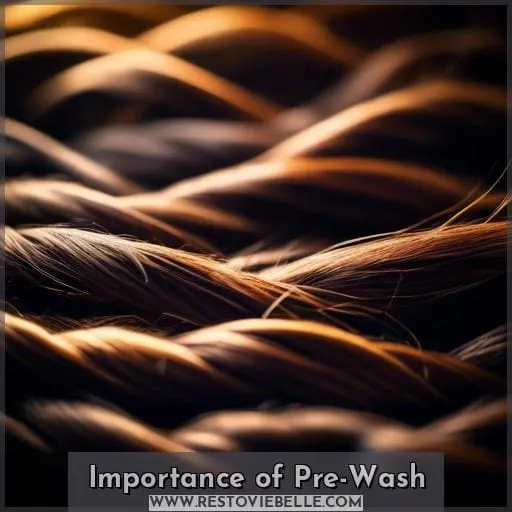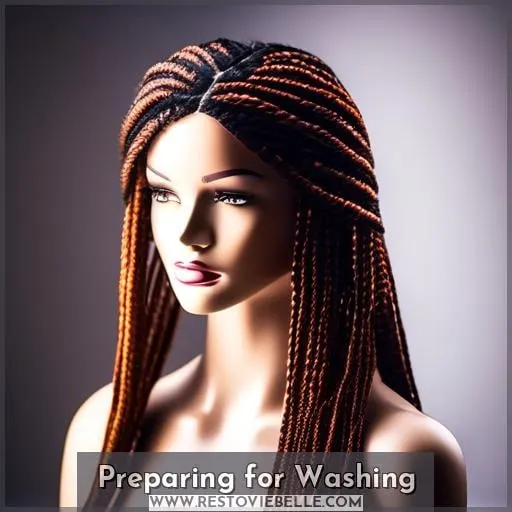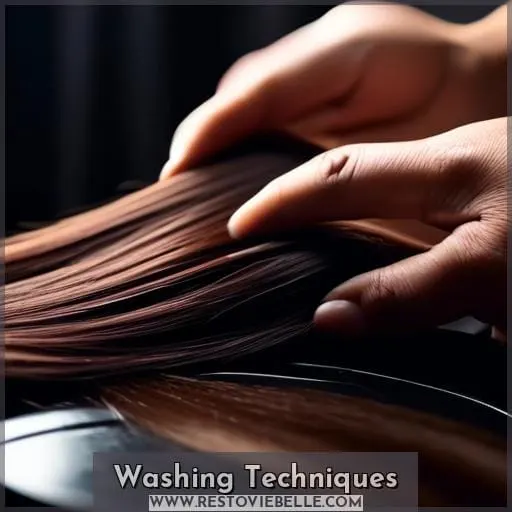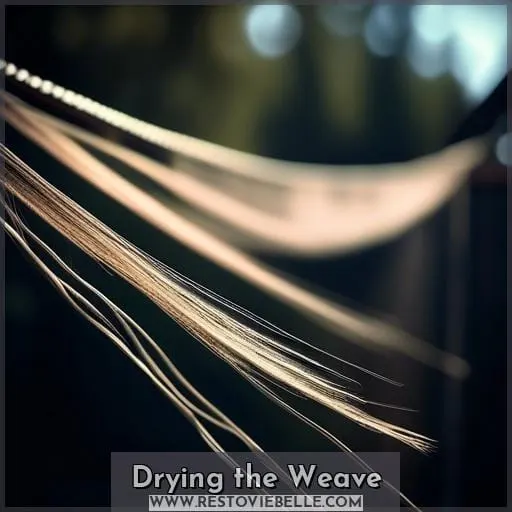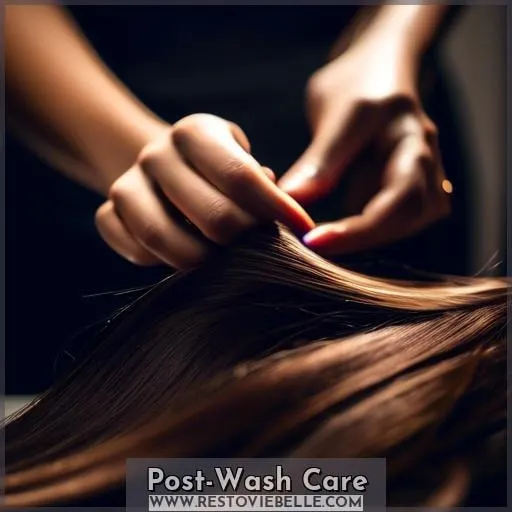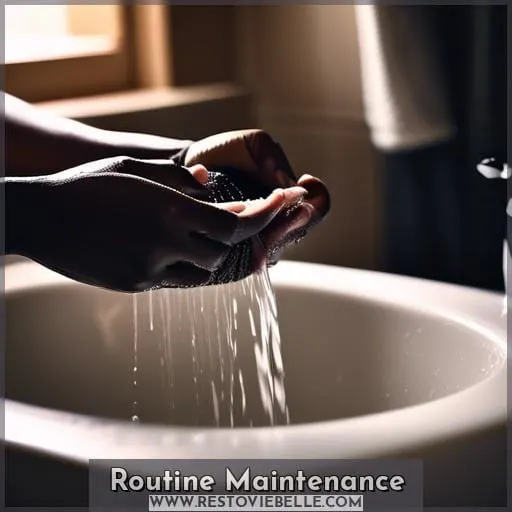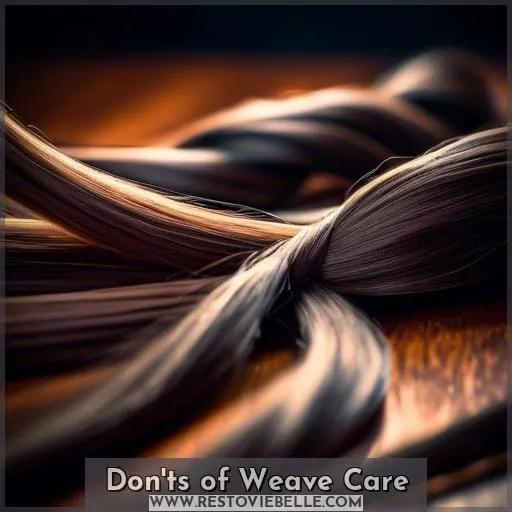This site is supported by our readers. We may earn a commission, at no cost to you, if you purchase through links.
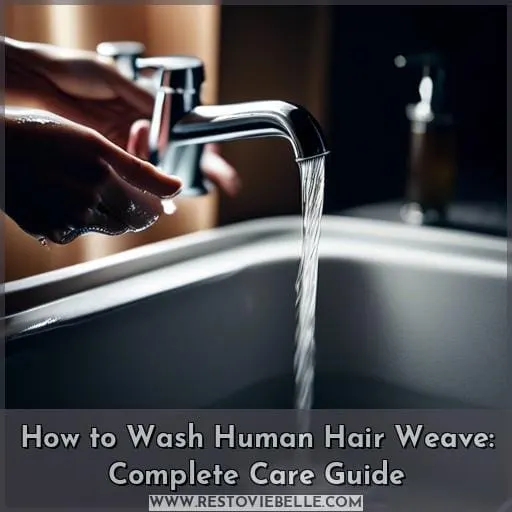 Maintaining your human hair weave with the right care routine is crucial for its longevity and appearance.
Maintaining your human hair weave with the right care routine is crucial for its longevity and appearance.
From the pre-wash preparations to routine maintenance, understanding how to wash your human hair weave is essential.
This guide will walk you through each step, ensuring your weave remains clean, vibrant, and healthy.
Whether you’re dealing with Brazilian hair, sew-in, or leave-out weaves, you’ll learn the do’s and don’ts of weave care, including selecting the right products, washing techniques, and drying methods.
Dive into the world of weave maintenance with confidence, embracing innovation and mastery in your hair care practices.
Yes, you can wash a human hair weave by first saturating it with warm water, applying a hydrating, sulfate-free shampoo, and then conditioning it. After washing, it’s crucial to thoroughly dry the weave to prevent mold and mildew.
Table Of Contents
- Key Takeaways
- Importance of Pre-Wash
- Preparing for Washing
- Washing Techniques
- Drying the Weave
- Post-Wash Care
- Routine Maintenance
- Do’s of Weave Care
- Don’ts of Weave Care
- Frequently Asked Questions (FAQs)
- Can I swim with my human hair weave, and if so, how should I care for it afterward?
- Is it safe to color or bleach a human hair weave, and what precautions should I take?
- How can I tell if my human hair weave is experiencing product buildup, and what steps should I take to address it?
- What are the best practices for sleeping with a human hair weave to prevent tangling and damage?
- Can I use heat styling tools on my human hair weave, and are there any specific heat protectants recommended?
- Conclusion
Key Takeaways
- Use sulfate-free shampoos to avoid damaging the weave and to keep it hydrated and vibrant.
- Detangle the weave starting from the tips and working towards the roots using a wide-tooth comb or Denman brush before washing.
- Wash the weave with warm water and a hydrating, sulfate-free shampoo, then condition it, ensuring thorough rinsing to prevent residue.
- Dry the weave gently using a towel, hood dryer, or blow dryer with a diffuser on low heat, and avoid high heat to protect the weave’s integrity.
Importance of Pre-Wash
Before installing your human hair weave, it’s crucial to give it a thorough wash. This pre-installation wash ensures the weave is clean, mimicking the common practice of washing new clothes before wearing them.
It not only prepares the weave for a smoother installation process but also enhances its appearance and condition, making your new hairstyle look its best right from the start.
Cleanliness and Installation Ease
Maintaining the cleanliness and ease of installation for your human hair weave begins with a thorough pre-wash routine. This crucial step ensures that any residue from manufacturing, shipping, and handling is removed, making the weave safer for your scalp and easier to style.
A clean weave not only looks better but also prevents potential damage and irritation to your scalp. Incorporating a pre-wash routine, followed by post-wash detangling and deep conditioning, into your hair care regimen is essential.
These steps not only prepare your weave for protective styling but also contribute to its longevity.
Regular washing with a sulfate-free shampoo, careful detangling, and moisturizing are key do’s in weave care. Conversely, avoid using harsh products and neglecting routine maintenance to prevent damage.
By adhering to these guidelines, you’ll ensure your human hair weave remains in pristine condition, enhancing your overall look.
Preventing Damage and Irritation
To prevent damage and irritation when wearing a human hair weave, it’s crucial to prioritize avoiding breakage and preventing tangles.
Opting for natural products can significantly contribute to maintaining the weave’s shine and extending its lifespan. Utilizing tools like a Denman brush or a wide-tooth comb can help detangle without causing stress to the hair.
Additionally, incorporating moisturizing conditioner and hair oils such as coconut oil into your routine ensures the weave remains hydrated and less prone to tangling. Regular application of a small amount of hair-conditioning oil can also soothe the scalp and promote overall hair health.
This approach not only preserves the weave’s aesthetic appeal but also supports the well-being of your natural hair underneath.
Preparing for Washing
Before you begin washing your human hair weave, it’s essential to select the right shampoo and detangle the hair.
Opt for a sulfate-free shampoo that’s gentle on the weave, and carefully remove any knots or tangles with a wide-tooth comb or a Denman brush.
This preparation ensures that your weave is clean without causing damage, and it sets the stage for a successful wash that maintains the hair’s quality and appearance.
Selecting the Right Shampoo
Selecting the right shampoo for your human hair weave is crucial for maintaining its beauty and longevity. Opt for sulfate-free shampoos, as they’re gentler on the hair and scalp, reducing the risk of stripping away natural oils.
Products like BeautiMark’s Hydra Shampoo are specifically formulated for processed human hair, focusing on toxin-free care by eliminating harsh chemicals like parabens and sulfates. This approach ensures your weave remains hydrated, vibrant, and free from damage.
Regular maintenance with such shampoos, complemented by moisturizing conditioners, will keep your human hair extensions looking their best. Gentle massaging during washing helps in effectively cleansing the scalp and hair without causing any harm.
Avoid harsh products to prevent damage and ensure the longevity of your weave.
Detangling Before Soaking
When transitioning from selecting the right shampoo to detangling before soaking, it’s crucial to approach your human hair weave with care.
Before immersing your weave in water, ensure it’s free of tangles to prevent damage. Start by gently separating your hair into manageable sections. This not only makes the process easier but also ensures that each strand is thoroughly cleaned.
Using preferred detangling tools like a wide-tooth comb or a Denman brush, begin at the tips of your hair and work your way up to the roots, minimizing breakage.
For dry detangling, consider lightly moistening your weave with a mixture of water and a pre-soak product, such as a light conditioner or oil, to ease the process. This step is vital for maintaining the integrity of your weave, ensuring it remains smooth and manageable throughout the washing process.
Washing Techniques
When it comes to washing your human hair weave, it’s essential to do it correctly to maintain its quality and extend its lifespan.
Start by thoroughly saturating the weave with warm water, ensuring it’s completely wet before applying any products.
Next, use a gentle, sulfate-free shampoo to cleanse the hair, taking care to rinse it out thoroughly to prevent any residue build-up.
Finally, indulge your weave in a conditioning soak, allowing the product to penetrate and hydrate the hair for a set period before rinsing it out completely.
This process will help keep your weave looking fresh and vibrant.
Saturating the Weave
After selecting the right sulfate-free shampoo and detangling your hair weave, it’s time to focus on saturating the weave properly.
- Begin by wetting the weave with warm water to fully saturate each strand.
- Gently apply the shampoo, avoiding rough movements to prevent tangles.
- Rinse thoroughly to remove buildup, ensuring no shampoo residue is left.
- Soak the weave if necessary, but avoid excessive soaking to prevent breakage.
Shampooing and Rinsing
After saturating your weave with warm water, it’s time to focus on shampooing and rinsing. Apply a hydrating, sulfate-free shampoo to your weave, massaging it gently to ensure even coverage.
Rinse thoroughly to prevent product buildup. Next, apply a conditioner designed for human hair, which offers numerous benefits such as added moisture and easier detangling. Allow the conditioner to soak in, enhancing the weave’s manageability and appearance.
When it’s time to dry, opt for gentle methods. A t-shirt can be a great alternative to a rough towel, reducing frizz and breakage. If using a blow dryer, employ a diffuser to distribute heat evenly and prevent damage.
For leave-out weaves, air drying is a viable option, but ensure the weave is completely dry to avoid issues like mold. Regular use of appropriate styling products can maintain the weave’s luster and prolong its life.
Conditioning Soak
To ensure your human hair weave remains in pristine condition, a conditioning soak is a crucial step in the washing process. This step involves immersing your weave in a solution of water and conditioner, specifically chosen for its conditioning ingredients.
The benefits of this method are manifold, including enhanced softness, increased manageability, and the prevention of tangling and dryness. For sew-in weaves, deep conditioning under a hooded hair dryer can significantly improve the weave’s health, offering a salon-like treatment at home.
When dealing with clip-in human hair extensions or extension bonding glue, this step helps maintain the integrity of the hair and ensures the longevity of your investment. The timing of the soak—ranging from 15 to 60 minutes—allows the conditioning ingredients to penetrate deeply, revitalizing the weave and leaving it looking and feeling rejuvenated.
Drying the Weave
After you’ve washed your human hair weave, it’s crucial to dry it properly to maintain its quality and appearance.
Towel drying by gently patting the hair can help remove excess water without causing tangles. For thorough drying, you can sit under a hood dryer for about 45 minutes, ensuring the weave is completely dry, which prevents potential damage like matting or odors.
If a hood dryer isn’t available, using a blow dryer with a diffuser on a low heat setting can also be effective, or you can opt to air dry the weave if time allows.
Towel and Air Drying
After washing your weave, towel drying can be a gentle method to remove excess water before air drying. Towel benefits include less heat damage and the preservation of hair texture. However, it’s crucial to use a microfiber towel to minimize frizz and prevent roughing up the hair cuticles.
Air drying benefits your weave by reducing the risk of heat damage and maintaining its natural wave or curl pattern. Understanding the drying differences between towel and air drying can help you choose the best method for your hair’s health and style.
- Opt for a microfiber towel to minimize frizz and breakage.
- Gently blot and squeeze, don’t rub, to protect hair integrity.
- Air drying preserves natural textures and prevents heat damage.
- Ensure proper ventilation while air drying to avoid mildew.
- Comb through gently to detangle and aid even drying.
Using a Hood or Blow Dryer
When transitioning from towel to air drying, consider the efficiency and convenience of using a hood or blow dryer for your human hair weave.
These tools offer advanced blowout techniques, ensuring your weave dries evenly without compromising its texture. Opt for a dryer with a diffuser attachment to distribute heat gently, preserving the weave’s natural movement and reducing frizz.
Pay attention to heat settings to avoid damage, and for those always on the move, select a model boasting travel portability. Additionally, investing in a dryer with warranty coverage provides peace of mind, ensuring your styling tool remains a reliable part of your hair care routine.
Post-Wash Care
After washing your human hair weave, it’s crucial to focus on detangling and styling, as well as applying oils and serums for optimal health and shine.
Start by gently detangling your weave with a wide-tooth comb or a specialized brush like the Denman Curly Hair Brush D3, which is designed to minimize damage and maintain the weave’s integrity.
Next, nourish and protect your hair by applying a lightweight hair serum or natural oil, such as the Luodais serum recommended for human hair wigs, ensuring to distribute the product evenly for a silky, vibrant finish.
This post-wash care routine not only enhances the appearance of your weave but also contributes to its longevity and ease of styling.
Detangling and Styling
After washing your human hair weave, detangling and styling are crucial steps to ensure your weave looks its best.
- Detangling Techniques: Start by gently separating your weave into manageable sections. Use a wide-tooth comb or a Denman brush to carefully detangle each section from the tips to the roots, minimizing breakage and shedding.
- Styling Products: Invest in quality leave-in conditioners and hair masks specifically designed for human hair weaves. These products will help to keep your weave moisturized, reduce frizz, and make styling easier.
- Blow Drying Tips: If you choose to blow dry your weave, use a diffuser attachment to evenly distribute heat and prevent damage. Keep the dryer on a low heat setting and move it continuously to avoid concentrating heat in one area.
By following these guidelines, you can maintain the health and appearance of your human hair weave, ensuring it remains soft, manageable, and stylish.
Applying Oils and Serums
After detangling and styling your human hair weave, it’s time to lock in moisture and add a layer of protection.
Apply oils or serums to nourish and shield your strands. Opt for products like The Hair Shop Silk Drops, infused with coconut and sunflower oil, which are designed to smooth and add shine while protecting the hair.
Luodais serum is also recommended for its moisturizing benefits. These products not only enhance the health of your weave but also extend its lifespan by keeping it hydrated and resilient against environmental stressors.
Routine Maintenance
To ensure your human hair weave remains in top condition, it’s crucial to adopt a routine maintenance schedule that includes regular shampooing and intervals for deep conditioning.
Washing your weave with a sulfate-free shampoo helps prevent dryness and maintains the hair’s natural moisture. Deep conditioning treatments restore hydration and vitality to the hair, keeping it looking fresh and vibrant.
This approach not only prolongs the life of your weave but also ensures it remains soft, manageable, and stylish.
Regular Shampooing
Maintaining your human hair weave with regular shampooing is crucial for its longevity and appearance. After detangling and styling, it’s time to focus on routine maintenance, which includes selecting the right shampoo and employing proper drying techniques.
Opt for a sulfate-free shampoo to prevent stripping the weave of its natural oils, which can lead to dryness and tangling. Pre-wash preparation, such as gently brushing out any knots, will make the washing process smoother and more effective.
When shampooing, ensure you’re thorough yet gentle, to avoid causing stress to the weave. After washing, carefully dry your weave using a towel or air dry method, as excessive heat can damage the hair.
Post-wash detangling is also important to maintain the weave’s quality and to prevent matting.
Incorporate deep conditioning into your routine maintenance every week and a half to keep the weave soft and manageable. Applying oils and serums can add an extra layer of moisture and protection, enhancing the weave’s natural shine and health.
By adhering to these guidelines, you’ll ensure your human hair weave remains in pristine condition, looking as fresh and vibrant as the day it was installed.
Deep Conditioning Intervals
To maintain the health and longevity of your human hair weave, it’s crucial to incorporate deep conditioning into your routine maintenance. Deep conditioning replenishes moisture and nutrients, ensuring your weave remains soft, tangle-free, and vibrant.
Aim for a frequency that suits your hair’s needs; typically, every one to two weeks is beneficial. When selecting products, opt for those specifically recommended for weaves, such as hydrating formulas free from harsh chemicals.
Apply your chosen deep conditioner evenly, covering each strand from roots to ends, and consider using a plastic shower cap to enhance the treatment’s effects. After the recommended time, usually between 15 to 30 minutes, rinse thoroughly with cool water to seal the hair cuticles and lock in moisture.
Do’s of Weave Care
When it comes to caring for your human hair weave, gentle handling and protection are paramount. Always treat your weave with the same care you’d your natural hair, especially when swimming.
Before taking a dip, apply a leave-in conditioner to create a barrier against harmful chlorine and saltwater, and consider styling your hair in a way that minimizes exposure to these elements.
This approach not only maintains the health and appearance of your weave but also extends its lifespan, ensuring you can enjoy your enhanced hairstyle for longer.
Gentle Handling
Continuing from the importance of regular shampooing and deep conditioning, let’s focus on the gentle handling of your human hair weave.
- Use detangling methods that are gentle, such as wide-tooth combs or specialized detangling brushes.
- Look for product recommendations that are specifically designed for weaves, like sulfate-free shampoos.
- Check shampoo ingredients for natural oils and avoid harsh chemicals that can damage the weave.
- Employ drying techniques that minimize heat exposure, like air drying or using a hood dryer on a cool setting.
- Practice pre-wash detangling to reduce knots and make the washing process smoother.
Protecting While Swimming
Before diving in, safeguard your human hair weave from chlorine damage by donning a swim cap.
Chlorine can be harsh, stripping moisture and causing tangles. Apply protective products that offer UV protection to shield against the sun’s drying effects.
Post-swim, consider washing your weave to remove any chlorine residue, ensuring its longevity and reducing the need for frequent reinstallation.
Don’ts of Weave Care
When caring for your human hair weave, it’s crucial to avoid certain practices to maintain its quality and longevity.
Firstly, steer clear of excessive heat, as it can damage the hair fibers, making them brittle and prone to breakage.
Additionally, ensure your weave is completely dry after washing to prevent mold and mildew.
These simple precautions help keep your weave looking fresh and extend its lifespan.
Avoiding Excessive Heat
Avoiding excessive heat is crucial when caring for your human hair weave.
Heat styling, if overdone, can lead to heat damage, making your weave brittle and lifeless. Always use heat protection before employing heat tools like flat irons or curling wands.
When blow drying, opt for a lower temperature setting to prevent stress on the hair fibers. Remember, consistent exposure to high heat can strip the weave of its natural moisture, leading to a dull appearance.
Instead, embrace heatless styling methods when possible to maintain the vitality of your weave.
Preventing Mold and Mildew
To prevent mold and mildew in your human hair weave, prioritize proper storage and cleaning.
Always ensure your weave is completely dry before storing it to avoid moisture buildup, which can foster mold growth. Opt for a ventilated area that’s cool and dry to keep your weave fresh and free from mildew.
Regular cleaning, coupled with thorough drying, is essential for mold prevention. If you’re using a hair dryer, select a moderate heat setting to avoid damaging the weave while ensuring it’s fully dry.
Proper ventilation during and after washing your weave is crucial to prevent any dampness that could lead to mold or mildew issues.
Frequently Asked Questions (FAQs)
Can I swim with my human hair weave, and if so, how should I care for it afterward?
Yes, you can swim with your human hair weave, but it’s crucial to protect it from chlorine and salt water.
After swimming, rinse your hair immediately, use a sulfate-free shampoo, and follow with a deep conditioner to restore moisture.
Air dry or use a low heat setting to dry your weave.
Is it safe to color or bleach a human hair weave, and what precautions should I take?
Yes, it’s safe to color or bleach a human hair weave.
70% of women report significant hair damage post-bleaching.
Always use quality bleach and follow with deep conditioning.
Consult a professional to minimize risks and maintain hair integrity.
How can I tell if my human hair weave is experiencing product buildup, and what steps should I take to address it?
To identify product buildup in your human hair weave, look for dullness, dryness, or a heavy feeling.
Combat buildup by using a clarifying shampoo, rinsing with apple cider vinegar, or adding baking soda to your routine.
What are the best practices for sleeping with a human hair weave to prevent tangling and damage?
To prevent tangling and damage, sleep with your human hair weave in a loose braid or bun.
Use a silk or satin pillowcase or bonnet to reduce friction.
Can I use heat styling tools on my human hair weave, and are there any specific heat protectants recommended?
Yes, you can use heat styling tools on your human hair weave. Always apply a heat protectant before styling to prevent damage.
Zala’s Revive Me spray is recommended for its nourishing properties.
Conclusion
Ironically, the simplest tasks can sometimes be the most crucial. Washing your human hair weave is no exception. It’s not just about keeping it clean; it’s about preserving the life and luster of your investment.
You’ve learned the importance of pre-wash, the art of selecting the right products, and the technique of washing and drying your weave. Now, remember to maintain a regular care routine, treat your weave gently, and avoid the pitfalls that can lead to damage.
With these tips in mind, you’re set to keep your human hair weave looking as fresh and vibrant as the day you got it. Embrace this knowledge, and your weave will continue to be a crowning glory that turns heads.

